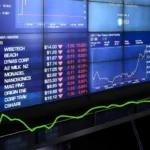Investor concerns are on the rise following an attack on an American warship and commercial vessels in the Red Sea on Sunday. The incident, which involves reports of drone and missile attacks claimed by Yemen’s Houthi group on two Israeli vessels, raises fears of the potential risks for the Israel-Hamas conflict and geopolitical tensions. The Pentagon acknowledged the reports, heightening worries about the involvement of the U.S. and regional players like Iran.
The situation can potentially complicate the outlook for the recent stock market rally that saw U.S. stocks reaching a fresh closing high for the year. Quincy Krosby, chief global strategist at LPL Financial, noted that a broader conflict could prompt some investors to profit from recent market gains. The S&P 500, having risen nearly 9% in November, is up almost 20% for the year.
In response to the developments, S&P 500 futures dipped slightly in Asia trade, Brent crude futures rose by 0.7% to $79.40 per barrel, and gold reached a record high of $2,111 per ounce. Geopolitical tensions often drive investors toward traditional safe havens such as gold, Treasuries, and the U.S. dollar.
Phil Orlando, chief equity market strategist at Federated Hermes, points out that rising regional tensions could potentially push West Texas Intermediate crude prices to $80 to $90 per barrel. However, Orlando maintains his conviction that the S&P 500 will end the year at 4,600, even though a spike in geopolitical tensions could temporarily drop the index by “one or two hundred points.”
As investors monitor these geopolitical developments, attention is also focused on upcoming factors that could influence the market, including the U.S. employment report due on Friday, the Federal Reserve’s monetary policy meeting on December 12-13, and seasonal factors like tax-loss selling and the “Santa Claus rally.” The situation remains fluid, and investors keenly observe how these geopolitical tensions might shape market dynamics in the coming weeks.












